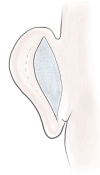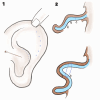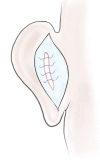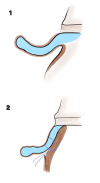A Simple Working Classification for Effective Surgical Management of Prominent Ears
- PMID: 39981453
- PMCID: PMC11839306
- DOI: 10.7759/cureus.77740
A Simple Working Classification for Effective Surgical Management of Prominent Ears
Abstract
Prominent ear or prominauris is the most common congenital deformity of the ear. Children may get bullied in school because of this, and patients usually seek treatment for prominent ears because of psychosocial concerns even though functionally there are no issues. Numerous surgical procedures are described for correction of prominauris but there is no single procedure that gives consistent and satisfying outcomes. There are different classifications proposed but there is no simple classification described that would guide surgeons to better identify the deformity and to make a decision on specific surgical steps to be followed accordingly to give satisfactory and consistent results. We propose a classification to grade prominauris into three grades which will help in the decision-making in the surgical steps required for its correction.
Keywords: antihelix formation; conchal setback; otoplasty; prominent ears; scaphoconchal sutures.
Copyright © 2025, P et al.
Conflict of interest statement
Human subjects: Consent for treatment and open access publication was obtained or waived by all participants in this study. Animal subjects: All authors have confirmed that this study did not involve animal subjects or tissue. Conflicts of interest: In compliance with the ICMJE uniform disclosure form, all authors declare the following: Payment/services info: All authors have declared that no financial support was received from any organization for the submitted work. Financial relationships: All authors have declared that they have no financial relationships at present or within the previous three years with any organizations that might have an interest in the submitted work. Other relationships: All authors have declared that there are no other relationships or activities that could appear to have influenced the submitted work.
Figures








References
-
- Analysis in otoplasty. Becker DG, Lai SS, Wise JB, Steiger JD. Facial Plast Surg Clin North Am. 2006;14:63-71, v. - PubMed
-
- Psychosocial outcome of patients after ear reconstruction: a retrospective study of 62 patients. Horlock N, Vögelin E, Bradbury ET, Grobbelaar AO, Gault DT. Ann Plast Surg. 2005;54:517–524. - PubMed
-
- The treatment of prominent ears. Jayes PH, Dale RH. https://doi.org/10.1016/S0007-1226(51)80034-1. Br J Plast Surg. 1951;4:193–201. - PubMed
-
- Correction of prominent ears by conchamastoid sutures. Furnas DW. Plast Reconstr Surg. 1968;42:189–193. - PubMed
-
- Treatment of prominent ears and otoplasty: a contemporary review. Pawar SS, Koch CA, Murakami C. JAMA Facial Plast Surg. 2015;17:449–454. - PubMed
LinkOut - more resources
Full Text Sources
